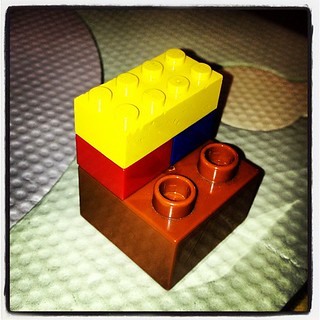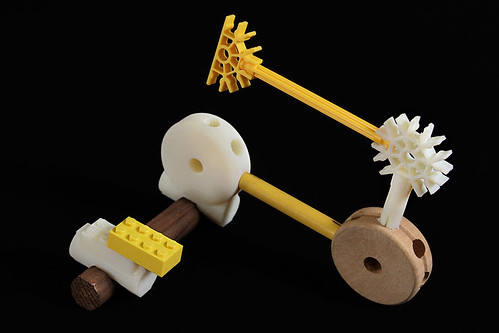
Friday, October 18, 2013
Nikola Tesla
Nikola Tesla, shown here by Connor Wingard, was an engineer and prolific inventor. He is known, among other things, for his important work in competition with Edison, developing electricity as a practical source of energy for consumers, including the development of alternating current.


Wednesday, October 16, 2013
Book review: Beautiful LEGO
Beautiful LEGO by Mike Doyle, 2013, No Starch Press
Please note that I'm posting this same review across my blogs, but I'm appending some blog-specific information at the end of each review.

A little while ago, Huw on Brickset noted the explosion of LEGO books in recent years. Some of those books are little more than catalogues of LEGO products (the 'here are all of the figures in the Harry Potter sets' type books), the really great thing about this trend is the great number of those books that are by, for, and about the AFOL community. The most recent addition to the growing bibliography is Mike Doyle's Beautiful LEGO, published by No Starch Press.
Beautiful LEGO is exactly what the title implies, a celebration of LEGO MOCs that are particularly gorgeous. The emphasis here is on the pictures - of the 266 pages in the book, only 17 of them have text. These text pages include a one page intro by Doyle about inspiring artistic MOCs and the creativity of the AFOL community, and a series of one to three page interviews with some of the builders. By my count 81 different builders contributed over 360 different MOCs. The subject matter is completely varied, from microscale buildings to full scale sculptures of everyday objects. The arrangement of MOCs is varied - in places Doyle gives several different builders' takes on the same subject matter, and in other places he places the spotlight on individuals, grouping a series of MOCs by the same person. The creations themselves run from humorous MOCs like some of Angus MacLane's Cube Dudes to some that are bright and fun like Thomas Poulsom's birds, to others that are dark and foreboding, like Doyle's own abandoned homes. As you can see from just those three examples, the builders include a lot of names that would be familiar to anyone who is active in the AFOL community - indeed most of the MOCs are ones I've seen featured on the various LEGO blogs. But just because I've seen them before, and by virtue of being someone reading my blogs you probably have as well, doesn't mean this isn't a wonderful book to own. It's a great collection of some of the best of the best, and perfect to peruse for inspiration, or just leave on your coffee table to amaze your non-LEGO friends. Indeed, I think this would be a great gift for a non-AFOL who just likes cool things (and it may even convert them into an AFOL).
Beautiful LEGO has one really nice thing that I think may be a unique innovation in this book. There is an index of contributors at the back, and for almost all of them Doyle provides a URL of where to find their work online (Flickr stream, personal site, a couple of MOCpages), and he includes the nickname they use on LEGO forums. This is great in a hobby where sometimes I only know people by their forum handles (indeed, since I've never been to a major AFOL convention, I still half believe that people look like their sig figures). I think this resource is a great tribute to the true heroes of the book, the community of awesome builders.
So are there any problems with this book? Sure. There's the unavoidable problem of selection. In the potentially infinite creativity of a worldwide community you'll always be able to ask "why not include this, or that?", a problem that Doyle recognizes in the preface. I'm a castle guy, and I would have loved to have seen more castles. I've been judging castle contests for a decade and could point to hundreds of castle MOCs that could easily sit alongside the other creations here. One critique that goes to No Starch rather than Doyle is that this really should be a hard cover book, in keeping with other coffee table books focused on beautiful pictures. A very minor critique is that two of the photos on the back cover are cut off at the top of the page. I think they were going for the effect of it looking like an endless collage of photos that keeps going, but if this were so they should have photos leading off all four sides of the page. My main critique, though, is with the presentation of the MOCs. Don't get me wrong, they are all high quality photos. Almost all of the photos are clear shots of the whole MOC in good lighting taken from the front, or with the MOC turned slightly to one side, with the camera looking slightly down. I guess in a book that was all about the creativity of the MOCs, I would have appreciated some more creativity of the photography - maybe some with different lighting effects, in silhouette, or with different filters on the camera, or some closeup details, or looking up at the moc from the base, that sort of thing.
On my blog ArtisticBricks I have several times asked the question "Is LEGO art?" or at least "Can LEGO be art?" Doyle answers that question with a resounding yes. One interesting thing I note is that while the minifig is ubiquitous in the world of AFOLs, there are almost no figs in this book. I wonder what that means? Is this just a reflection of Doyle's choices, or an indication that the fig is the distinction between playing and creating? That's something to think about, and I'd love to hear people's thoughts. Regardless, though, in this book Doyle has assembled a great portfolio of evidence that show that this thing we love is no mere toy, but a true medium for expression.
Blog-specific content: The science-themed MOCs in the book include Guy Himber's Orrery and Dave Kaleta's Frog Dissection. I keep meaning to feature Thomas Poulsom's birds, since they are so accurate they could illustrate an ornithology textbook.
Please note that I'm posting this same review across my blogs, but I'm appending some blog-specific information at the end of each review.

A little while ago, Huw on Brickset noted the explosion of LEGO books in recent years. Some of those books are little more than catalogues of LEGO products (the 'here are all of the figures in the Harry Potter sets' type books), the really great thing about this trend is the great number of those books that are by, for, and about the AFOL community. The most recent addition to the growing bibliography is Mike Doyle's Beautiful LEGO, published by No Starch Press.
Beautiful LEGO is exactly what the title implies, a celebration of LEGO MOCs that are particularly gorgeous. The emphasis here is on the pictures - of the 266 pages in the book, only 17 of them have text. These text pages include a one page intro by Doyle about inspiring artistic MOCs and the creativity of the AFOL community, and a series of one to three page interviews with some of the builders. By my count 81 different builders contributed over 360 different MOCs. The subject matter is completely varied, from microscale buildings to full scale sculptures of everyday objects. The arrangement of MOCs is varied - in places Doyle gives several different builders' takes on the same subject matter, and in other places he places the spotlight on individuals, grouping a series of MOCs by the same person. The creations themselves run from humorous MOCs like some of Angus MacLane's Cube Dudes to some that are bright and fun like Thomas Poulsom's birds, to others that are dark and foreboding, like Doyle's own abandoned homes. As you can see from just those three examples, the builders include a lot of names that would be familiar to anyone who is active in the AFOL community - indeed most of the MOCs are ones I've seen featured on the various LEGO blogs. But just because I've seen them before, and by virtue of being someone reading my blogs you probably have as well, doesn't mean this isn't a wonderful book to own. It's a great collection of some of the best of the best, and perfect to peruse for inspiration, or just leave on your coffee table to amaze your non-LEGO friends. Indeed, I think this would be a great gift for a non-AFOL who just likes cool things (and it may even convert them into an AFOL).
Beautiful LEGO has one really nice thing that I think may be a unique innovation in this book. There is an index of contributors at the back, and for almost all of them Doyle provides a URL of where to find their work online (Flickr stream, personal site, a couple of MOCpages), and he includes the nickname they use on LEGO forums. This is great in a hobby where sometimes I only know people by their forum handles (indeed, since I've never been to a major AFOL convention, I still half believe that people look like their sig figures). I think this resource is a great tribute to the true heroes of the book, the community of awesome builders.
So are there any problems with this book? Sure. There's the unavoidable problem of selection. In the potentially infinite creativity of a worldwide community you'll always be able to ask "why not include this, or that?", a problem that Doyle recognizes in the preface. I'm a castle guy, and I would have loved to have seen more castles. I've been judging castle contests for a decade and could point to hundreds of castle MOCs that could easily sit alongside the other creations here. One critique that goes to No Starch rather than Doyle is that this really should be a hard cover book, in keeping with other coffee table books focused on beautiful pictures. A very minor critique is that two of the photos on the back cover are cut off at the top of the page. I think they were going for the effect of it looking like an endless collage of photos that keeps going, but if this were so they should have photos leading off all four sides of the page. My main critique, though, is with the presentation of the MOCs. Don't get me wrong, they are all high quality photos. Almost all of the photos are clear shots of the whole MOC in good lighting taken from the front, or with the MOC turned slightly to one side, with the camera looking slightly down. I guess in a book that was all about the creativity of the MOCs, I would have appreciated some more creativity of the photography - maybe some with different lighting effects, in silhouette, or with different filters on the camera, or some closeup details, or looking up at the moc from the base, that sort of thing.
On my blog ArtisticBricks I have several times asked the question "Is LEGO art?" or at least "Can LEGO be art?" Doyle answers that question with a resounding yes. One interesting thing I note is that while the minifig is ubiquitous in the world of AFOLs, there are almost no figs in this book. I wonder what that means? Is this just a reflection of Doyle's choices, or an indication that the fig is the distinction between playing and creating? That's something to think about, and I'd love to hear people's thoughts. Regardless, though, in this book Doyle has assembled a great portfolio of evidence that show that this thing we love is no mere toy, but a true medium for expression.
Blog-specific content: The science-themed MOCs in the book include Guy Himber's Orrery and Dave Kaleta's Frog Dissection. I keep meaning to feature Thomas Poulsom's birds, since they are so accurate they could illustrate an ornithology textbook.
Wednesday, October 9, 2013
Chemistry prize!
Congratulations to Karplus, Levitt and Warshel on the 2013 Chemistry Nobel. These three made important strides in integrating the two sides of computational modeling. Computational chemists use two different methods to simulate molecules and make predictions about their structures and properties. Molecular mechanics, MM, uses classical physics and treats atoms as balls and springs. This does not give very exact answers, but these calculations are very fast and can be used for large systems (e.g. proteins). Quantum mechanics, QM, treats electrons individually. This gives very exact answers, but molecules that have only ten or twenty atoms can sometimes take many hours to complete, so things like proteins would take lifetimes to calculate. QM/MM is the solution. Karplus, Levitt and Warshel worked out ways to integrate the two methods so that large systems could be broken into parts, with part treated with MM and the other part treated with QM. This allows you to take some big system, like an enzyme, and very quickly solve the structure of the larger part with MM, but closely model reactions in the active site using QM.
To make an analogy, let's look at DUPLO and System LEGO. DUPLO are the larger blocks built for young children (my almost-2-year-old loves to chew on these). System bricks are what you probably think of as LEGO. You may not have realized it, but these two types of pieces can be combined:

Some LEGO builders use this trick when making large creations. DUPLO bricks are larger, and can quickly build up big mountains or whatever, but System bricks can be used to make the final result much more detailed. Here we see this principle in a WIP of a train display.

Now, this isn't so hard, since DUPLO and System bricks are both by LEGO, and they designed these to integrate. But QM/MM is a different matter. The theories underlying them are completely unrelated, and the real difficulty that faced Karplus, Levitt and Warshel (and others) and the reason they were recognized by the Nobel committee, was how to develop tools that connected them together in a meaningful way. A couple of years ago, Golan Levin and Shawn Sims came up with a series of connection pieces that can link LEGO, Lincoln Logs, TinkerToys, and other building toys. They don't sell them, but they made the designs available so you can make your own with a 3D printer.

With these you can link up previously-unconnected constructions. It's QM/MM for the building toy world! Hmm, is their a Nobel for toys?

To make an analogy, let's look at DUPLO and System LEGO. DUPLO are the larger blocks built for young children (my almost-2-year-old loves to chew on these). System bricks are what you probably think of as LEGO. You may not have realized it, but these two types of pieces can be combined:

Some LEGO builders use this trick when making large creations. DUPLO bricks are larger, and can quickly build up big mountains or whatever, but System bricks can be used to make the final result much more detailed. Here we see this principle in a WIP of a train display.

Now, this isn't so hard, since DUPLO and System bricks are both by LEGO, and they designed these to integrate. But QM/MM is a different matter. The theories underlying them are completely unrelated, and the real difficulty that faced Karplus, Levitt and Warshel (and others) and the reason they were recognized by the Nobel committee, was how to develop tools that connected them together in a meaningful way. A couple of years ago, Golan Levin and Shawn Sims came up with a series of connection pieces that can link LEGO, Lincoln Logs, TinkerToys, and other building toys. They don't sell them, but they made the designs available so you can make your own with a 3D printer.

With these you can link up previously-unconnected constructions. It's QM/MM for the building toy world! Hmm, is their a Nobel for toys?

Tuesday, October 8, 2013
Physics prize!
Alright, after leaving a few hours for the medicine and physiology to have the top position here, it's time to celebrate the 2013 Physics Nobel, awarded to François Englert and Peter W. Higgs, for their work on the Higgs boson going back fifty years. They developed a theory that unified the weak interaction and electromagnetism and helps explain the Standard Theory of matter. One prediction of their theory was the Higgs boson, which was first observed experimentally about a year ago and confirmed earlier this year. These experiments were performed at CERN, in part using the ATLAS detector, here in LEGO form by Dr. Sascha Hehlhase.

So, anyone want to take bets on the Chemistry prize? I'll be following #nobel on Twitter early tomorrow morning to get the announcement because, yes, I'm that big a geek.

So, anyone want to take bets on the Chemistry prize? I'll be following #nobel on Twitter early tomorrow morning to get the announcement because, yes, I'm that big a geek.
Nobel week!
Okay, in my general blogging malaise recently, I've gotten behind in the most exciting week for science geeks. Better than March Madness, better even than Shark Week, it's Nobel week! Monday (okay, it was a day ago, I missed it), is Physiology or Medicine Day. The 2013 prize was jointly awarded to James E. Rothman, Randy W. Schekman and Thomas C. Südhof. These three scientists have done groundbreaking work in examining how molecules are moved around in the cell. Molecules are wrapped up in membrane bound parcels called vesicles. These three looked at how the transfer of these parcels and their unwrapping to release their contents is regulated in the cell. Essentially they worked out how the cellular post office works (this picture is of an official DUPLO set, btw).


Subscribe to:
Comments (Atom)